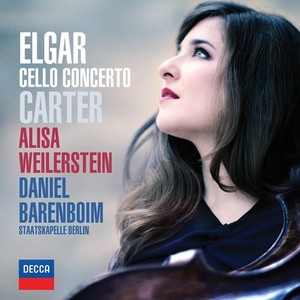 There is a big, dissonant filling inside Alisa Weilerstein‘s delicious cello album sandwich just released by Decca: the 2001 Cello Concerto by Elliott Carter, who died at age 104 last week.
There is a big, dissonant filling inside Alisa Weilerstein‘s delicious cello album sandwich just released by Decca: the 2001 Cello Concerto by Elliott Carter, who died at age 104 last week.
- Classical Music 101: What Does A Conductor Do? - June 17, 2019
- Classical Music 101 | What Does Period Instrument Mean? - May 6, 2019
- CLASSICAL MUSIC 101 | What Does It Mean To Be In Tune? - April 23, 2019
Carter, revered in life, was glorified in death as one of the great composers of our time.
But I can’t help wondering if this is actually true. The real judge will be posterity, but I can’t help but weigh in.
Before I start, I want to make clear that I thought Carter a charming, intellectually intimidating man. He was a very gracious interview and had a broad perspective of the world in which he lived and worked.
But Carter, like so many other artists, lived to challenge, not to fit in. He valued his craft more than its acceptance by as many people as possible.
This is the motivating impulse behind our Western cosmos, where everything needs to be in constant evolution. Without artists like Carter, we would not have progress in art music. The same could be said for Bach, Beethoven, Berlioz, Stravinsky and Schoenberg in their day.
But I think we too frequently confuse deliberate difficulty with greatness and mistakenly associate a popular touch with mediocrity.
Daniel Barenboim, who conducted the Staatskapelle Berlin for Weilerstein’s album, had this to say last week in Die Zeit about Carter, whom he considered a friend.
For me personally, Elliott Carter was and remains one of the most meaningful composers of the late 20th and early 21st centuries because he represents substance. He was the living proof of uncompromising, complex music, which at first seems inaccessible. But it becomes accessible if one digs in and sees the development through. I believe that is Carter’s great lesson: to always stay uncompromisingly focused on the substance of the music — and not to try to incorporate popular elements, like so many composers today.
I would like to politely disagree.
With the benefit of hindsight and a few centuries of sands passing through history’s unsentimental sieve, I would like to propose that the true test of music’s greatness is not complexity, nor is it a clever concept (Carter’s music makes perfect, eye-opening sense once you spend a few hours carefully analyzing the score), but it is an ability to do two things at once: Allow any listener to find something inherently attractive while also rewarding those few people who are determined to find a higher design.
Any listener can appreciate a Beethoven sonata without knowing anything about what the sonata form is or how the composer is subverting it at every turn. Stravinsky’s Rite of Spring engages on many levels — from groin to gut to head, to borrow from America’s Funnest Home Videos.
So much of the composition of the latter half of the 20th century was about the head alone. And there are actually still people who wonder why the bulk of the art music audience continues to avoid new music the way a 2-year-old shuns Brussels sprouts.
There is a new generation of composers who, fortunately, are seeing things a bit differently, and are keen to engage listeners as passionately as they themselves are engaged in writing music.
Which brings me back to Weilerstein’s wonderful new album.
Its marquee work, Edward Elgar’s 1919 Cello Concerto is not an easy piece of music for either the performer or the listener. It doesn’t open with a big, brash flourish for orchestra and soloist; it opens in darkness. Its musical motifs are actually quite simple, yet woven together in clever ways. It is a piece a first-time listener can appreciate on the surface, yet it rewards the repeat visitor with fresh insights with every return.
Carter’s concerto rewards careful attention, so I listened to it several times for the opposite effect: not even a sense of enjoyment but a relaxed acceptance of the music’s unfolding or development, and could not find it. It is my failure, but I suspect I am not alone.
The disc concludes with the Max Bruch’s haunting 1881 setting of the Yom Kippur prayer, Kol Nidrei.
Weilerstein engages with everything she plays with passionate intensity, and she has found a similar-minded partner in conductor Barenboim. Hearing them together is a pleasure, and Barenboim’s carefully nuanced shaping of the fragmented orchestral part in the Carter concerto is remarkable.
It’s a disc that will satisfy as well as provoke.
For details and audio samples, click here.
John Terauds
- Classical Music 101: What Does A Conductor Do? - June 17, 2019
- Classical Music 101 | What Does Period Instrument Mean? - May 6, 2019
- CLASSICAL MUSIC 101 | What Does It Mean To Be In Tune? - April 23, 2019



